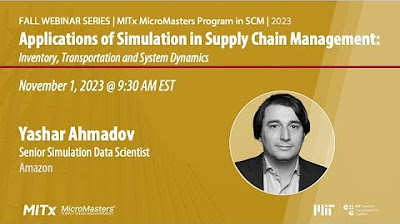Supply chain network design and inventory management for cost-efficient, in-time, perfect deliveries
Summary
TLDR在麻省理工学院(MIT)的春季系列直播活动中,Paulo Sousa Jr. 和 Miguel Rodriguez Garcia 共同主持了最后一次活动,邀请了 Wayfair 运营分析高级经理 Rafael Grillo Illipronti 作为嘉宾。Rafael 分享了 Wayfair 在网络设计和库存管理方面的策略,特别是如何通过优化配送网络和利用多级分销策略来实现成本效益、准时和完美交付。他讨论了 Wayfair 如何通过模拟和优化工具来权衡成本和速度,以及如何利用 AB 测试来衡量客户对交付速度的敏感性。此外,Rafael 还提到了 Wayfair 如何激励供应商在靠近客户的地点持有库存,以及如何通过激励而非强制的方式来影响供应商行为。最后,他提到了选择供应商时考虑的关键因素,包括产品类别管理和市场需求。整个讨论强调了学术理论与实际业务决策之间的联系,以及如何将复杂的供应链概念应用到现实世界中。
Takeaways
- 🎓 这是MIT供应链管理MicroMasters项目春季系列的第三次也是最后一次直播活动,前两次可以在MIT的Etiology YouTube频道观看。
- 🤝 Paulo Sousa Jr.和Miguel Rodriguez Garcia共同主持了这次活动,他们分别负责SC3x供应链动态和SC1x供应链基础课程。
- 📈 Rafael Grillo Illipronti作为演讲嘉宾,他是Wayfair运营分析部门的高级经理,负责全球履行中心网络设计。
- 🌐 Wayfair是一个连接供应商和客户的平台,专注于家具和装饰品市场,拥有国际化的供应商网络和遍及北美及欧洲的客户群。
- 🚀 Wayfair从纯粹的直运业务模式转变为投资建立物理分销网络,包括履行中心、交叉码头站、拉货点站和最后一公里交付站。
- 📊 Rafael强调了网络设计和库存管理在成本效率、及时交付和完美交付中的重要性,并分享了他在运营分析团队中的具体做法。
- 🔍 Wayfair使用模拟方法和经典优化方法的组合来分析成本与速度性能之间的各种场景和权衡。
- 📈 Rafael讨论了如何通过多级分销策略和安全库存管理来平衡库存水平和交付速度。
- 📝 他提到了如何使用AB测试来衡量客户对交付速度的敏感性,并将速度转化为销售价值。
- 🤔 在选择供应商时,Wayfair考虑的关键因素包括客户期望、供应商的地理位置、产品组合和市场特定需求。
- 📚 Rafael提到,MicroMasters项目的证书不仅有助于申请MIT的供应链管理混合硕士项目,也适用于全球其他大学。
- 📱 Rafael鼓励观众通过LinkedIn与他联系,以获取更多信息或提问。
Q & A
Wayfair的商业模式是什么?
-Wayfair是一个平台,连接供应商和消费者。供应商主要负责生产Wayfair网站上销售的家具和装饰品,而消费者则是购买这些商品的人。Wayfair不拥有库存,除了特定情况外,他们的目标是保持资产轻量化。最初,Wayfair是一个纯直运业务,完全依赖第三方物流,如FedEx和UPS进行配送。后来,Wayfair开始投资建立自己的物理分销网络,包括配送中心、交叉装卸站、拉式站点和最后一公里配送站点。
Wayfair如何确定产品在配送中心的存放位置?
-Wayfair使用运营分析团队开发的模型来确定产品在配送中心的存放位置。这些模型每六个月更新一次,以确保当前的决策与市场条件保持一致。他们考虑的因素包括运输成本、租金成本等长期趋势,而不是短期波动。
如何衡量配送速度对客户的重要性?
-Wayfair通过与竞争对手的比较和AB测试来衡量配送速度的重要性。AB测试涉及选择一些产品,对不同客户群体显示不同的预计交付时间,并测量这些变化对销售转化率的影响,从而了解客户对配送速度的敏感度。
Wayfair如何管理其全球供应链网络中的库存?
-Wayfair采用多级分销策略,将库存保留在区域中心(hubs),并根据靠近客户的配送中心(FCs)的消耗情况,从中心向这些配送中心运送产品。此外,Wayfair通过算法优化网站排名,激励供应商在更多地点持有库存,以提高产品的可用性和配送速度。
Wayfair如何选择供应商?
-供应商的选择更多是由Wayfair的品类管理部门负责,他们根据目标市场客户的预期和需求来选择供应商。这涉及到为不同地区的客户提供符合他们预期的产品组合。
Wayfair如何平衡成本和配送速度?
-Wayfair通过模拟不同的场景来平衡成本和配送速度。他们不追求单一的最优解,而是评估多个可行方案,并根据成本效益和速度进行权衡。他们还使用AB测试来了解不同客户群体对配送速度变化的敏感度,从而做出更有针对性的决策。
Wayfair的供应链网络设计有哪些关键考虑因素?
-Wayfair在设计供应链网络时,考虑的关键因素包括成本效率、配送速度、市场需求的预测准确性、安全库存的需求、产品的边际利润以及客户对快速配送的期望。
Wayfair如何决定在哪些地点建立配送中心?
-Wayfair通过分析长期趋势和市场条件,使用优化和模拟方法来决定在哪些地点建立配送中心。他们每六个月更新一次模型,以确认或调整之前的决策。
Wayfair的供应商主要位于哪些地区?
-Wayfair的供应商主要位于东南亚、中国,以及北美、加拿大和欧洲的部分地区。这些供应商通常是市场特定的,即北美的供应商通常只为北美市场服务。
Wayfair如何利用高级IT分析来辅助供应商选择过程?
-虽然选择供应商主要是品类管理部门的工作,但高级IT分析可以帮助他们更好地理解市场趋势、消费者行为和竞争对手的动态,从而做出更明智的供应商选择。
Wayfair的供应链管理教育课程有哪些?
-Wayfair的供应链管理教育课程包括MITx MicroMasters program中的五个课程,涵盖了供应链基础、供应链动态、运输与物流中心的课程等。
Wayfair的全球供应链网络有多大的规模?
-Wayfair的全球供应链网络服务于超过2000万客户,主要在北美、德国、英国和爱尔兰。他们的供应链网络包括超过1700万平方英尺的仓库空间,包括配送中心、交叉装卸站和配送站点。
Outlines

This section is available to paid users only. Please upgrade to access this part.
Upgrade NowMindmap

This section is available to paid users only. Please upgrade to access this part.
Upgrade NowKeywords

This section is available to paid users only. Please upgrade to access this part.
Upgrade NowHighlights

This section is available to paid users only. Please upgrade to access this part.
Upgrade NowTranscripts

This section is available to paid users only. Please upgrade to access this part.
Upgrade NowBrowse More Related Video

Global Supply Chains: How Did All This Stuff Get Here?

Applications of Simulation in Supply Chain Management

Strategic Sourcing in Supply Chain: Elevating Procurement for Business Success

Reshaping Business and Supply Chain Strategy Beyond Covid-19 with Professor Yossi Sheffi

MIT Supply Chain Management Master's Program Information Session with Student Panel

Supply Chain Risk Management and X shoring
5.0 / 5 (0 votes)
